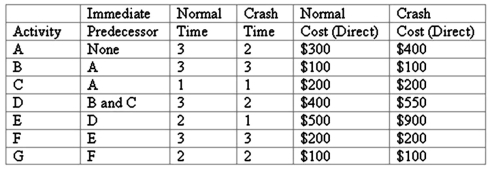You have collected the data for a time-cost CPM scheduling model analysis.The time is in days and the project "direct costs" are given here.  The indirect costs for the project are determined on a daily duration basis.If the project lasts 16 days, the total indirect costs are $400; 15 days, they will be $250; 14 days, they will be $200; and 13 days, they will be $100.If you crash this project by one day what is the total (i.e., direct and indirect) project cost? ____________________
The indirect costs for the project are determined on a daily duration basis.If the project lasts 16 days, the total indirect costs are $400; 15 days, they will be $250; 14 days, they will be $200; and 13 days, they will be $100.If you crash this project by one day what is the total (i.e., direct and indirect) project cost? ____________________
E.A costs $100/day to crash, D costs $150/day to crash, and E costs $400/day to crash.Reducing the duration of A by one day at an additional cost of $100 is the most economical.Direct costs are now $400 + $100 + $200 + $400 + $500 + $200 + $100 = $1,900.Overall duration of the project is 15 days, and indirect costs are $250.The total cost of crashing this project for one day is $2,150.
Definitions:
Open Systems
A concept in systems theory that describes entities or organizations which interact with their environment by exchanging energy, information, or materials.
General Systems Theory
A theoretical framework that views systems—whether biological, social, or physical—as coherent entities made up of interrelated and interdependent parts.
Continuous Exchange
An ongoing process of giving and receiving, often referring to information, goods, or services in various contexts.
Maslow's Hierarchy
A theory in psychology proposed by Abraham Maslow that suggests human needs are arranged in a hierarchy, starting from basic physical requirements to higher psychological needs, culminating in self-actualization.
Q14: "Supply chain" includes only inbound freight and
Q26: When developing an operations and supply chain
Q28: The term "assembly line" refers to progressive
Q29: Future search events minimize resistance to change
Q29: When recovering from a defective service encounter,
Q30: Give an example of a project layout._
Q31: Which of the following approaches to service
Q45: Implicit mental models are part of an
Q65: The critical path in a CPM analysis
Q84: Espoused values are usually socially undesirable.